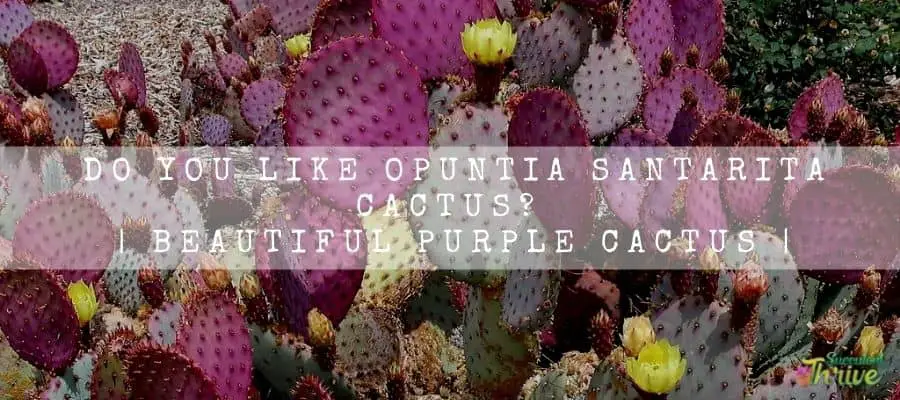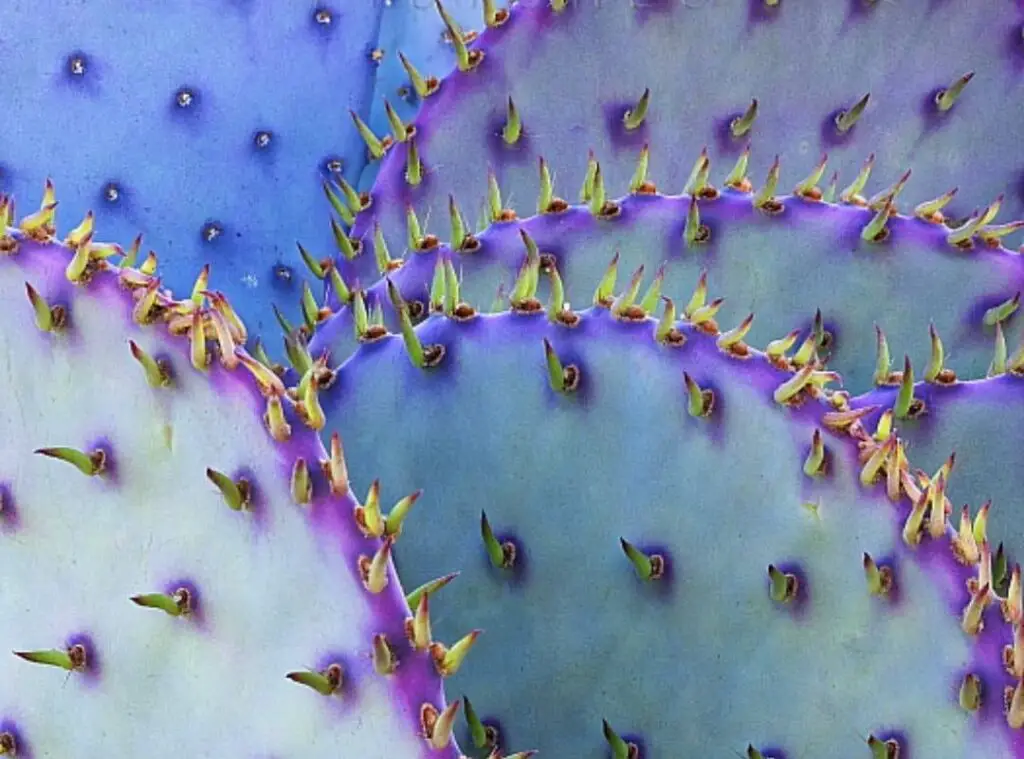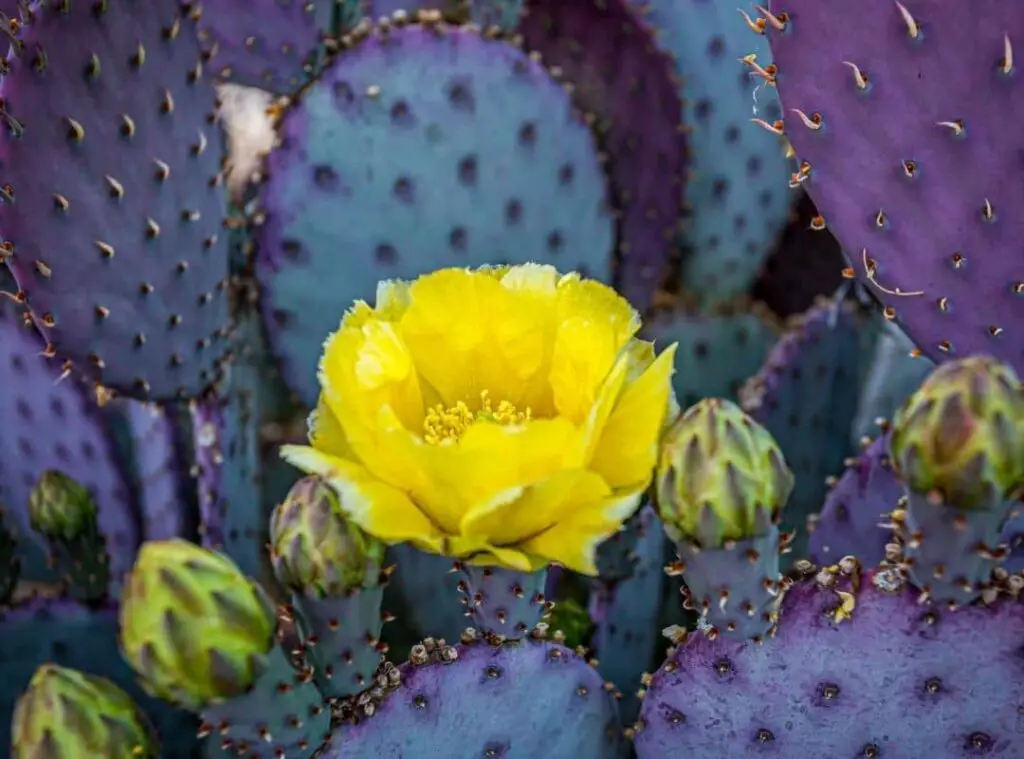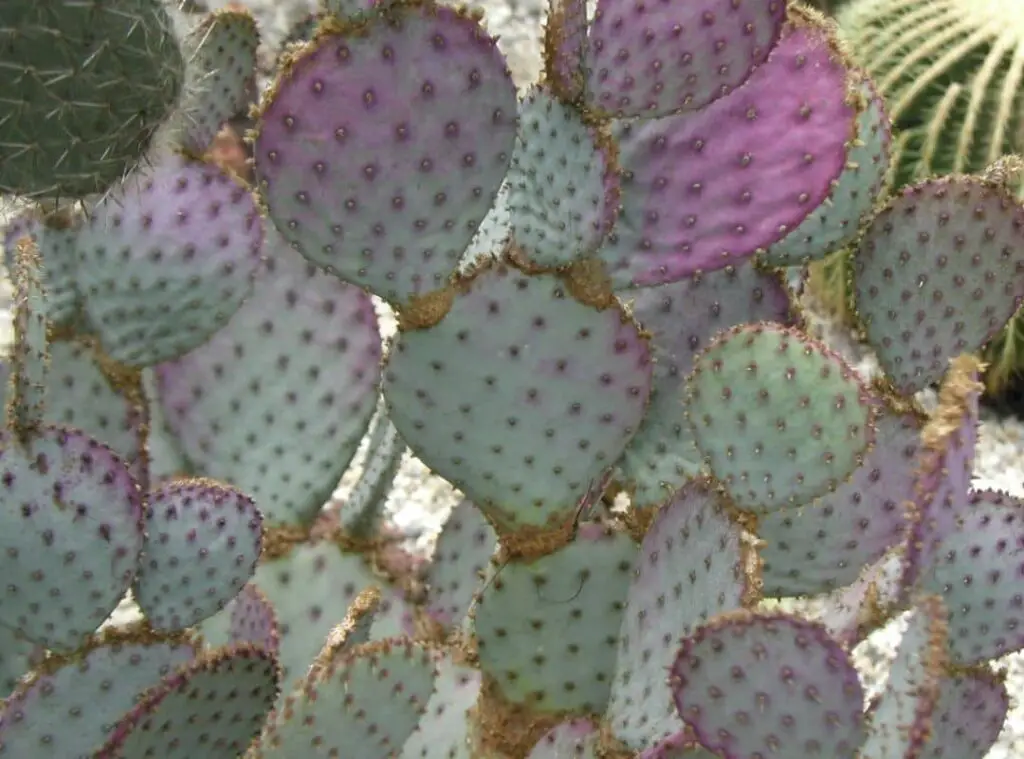Opuntia Santarita also known as Santa Rita prickly pear cactus and Blunt-spined prickly pear. These are native plants in the USA as well as in Mexico.
Succulents and cactus require only little care from you and Opuntia Santarita is no different to them. They would be great additions for xeriscape gardens, rock gardens and for cactus gardens and for containers as well.
Opuntia Santarita produces flowers and it is one more interesting feature of these plants.

How do I identify Opuntia Santarita?
Opuntia Santarita forms in an erecting manner. They usually grow in shrubs, and they would reach only up to 2 m in height and 3 m in width.
They will further consist of distinctive short trunks. They consist of pads in red or in violet color. Those pads would grow up to 8 inches in height. When they are in stress you could spot them in an intensified color.
In fact, you could spot the whole Opuntia Santarita in a more vivid color. The pads also comprise spines .
In addition to that Opuntia Santarita produces blooms in yellow. It would be a treat to watch them when they are in their full blossom during spring.
Once they complete flowering, they will form into a fruit which you could spot in oblong shape. The fruit would be purple in color and plump to the touch.
When the plant goes dormant, they will stay in attractive colors.
Size
Opuntia Santarita would reach a maximum height of 2 m and their maximum width would be 3 m.
Growth rate
They usually grow at a moderate rate.
One look care guide
| Botanical Name | Opuntia Santarita |
| Common Name | Santa Rita prickly pear cactus |
| Plant Type | Succulent cactus |
| Mature Size | Maximum height of 2 m / maximum width would be 3 m. |
| Sun Exposure | Full sunlight to partial shade |
| Soil Type | Well draining |
| Soil pH | Acid, Alkaline, Neutral. |
| Bloom Time | Spring |
| Flower Color | Yellow |
| Hardiness Zones | USDA hardiness zones 9-11. |
| Native Area | USA and Mexico |
| Toxicity | Non toxic |
| Average price | USD 15 |
How do you take care of Opuntia Santarita ?
Light Requirement
You should grow Opuntia Santarita and be exposed to at least 6 hours of full sunlight.
When you grow them as house plants, you need to grow them in the brightest sunny spot which could possibly be a window at your house.
If you wish to add them in your garden, you could proceed with a spot where they can receive both full sunlight and partial shade.

Temperature and humidity
Opuntia Santarita are fond of growing in hot and dry weather conditions. Having said that, they can thrive in mild winter conditions too.
However, they are not tolerant of high humidity levels. They could thrive well in room temperature level and in room humidity levels as well.
Ensure that you do not keep them in spots where they will be in close proximity to heat and cold drafts. If you do so, it will result in fluctuations in extreme temperature levels.
However, they are tolerant of intense temperature levels in summer.
Is it cold hardy?
Opuntia Santarita are resistant to frost conditions. In fact, they are hardy to -7 degrees Celsius temperature levels.
However, I recommend not to expose them to temperatures less than 0 degrees Celsius as it could be harmful.
If you have grown the plants in high humidity levels and if you are exposing the plants to frost conditions, it could lead to root rot.
USDA Hardiness Zone
Opuntia Santarita are usually hardy in USDA hardiness zones 9-11.
Watering Requirement
Opuntia Santarita has water conserved in their bodies. In fact, their flat and jointed stems act as water conserving plant parts.
This is what you call pads. When they are too young, you may consider watering them once every month during summer given that they do not get any rainfall. When they are matured and well established, you may water them on and off during summer.
If you spot their pads are skinny and if you cannot spot them as plump as it used to be, you need to start watering them deeply.
If the plants have been starved for water for too long, you will see how their pads become wrinkled. Having said that, they can revive with a one or two drinks of water.
Furthermore, ensure that you are letting the soil be dry between two watering sessions. If you supply them with excess water, it will cause discoloration of the pad color in the pads.

Soil Requirement Type / pH
Opuntia Santarita would thrive in various soil types. However, no matter which soil mix you grow, you should ensure that it has excellent drainage.
The purpose of providing a well-draining soil mix is to let the excess water drain through faster. Unless it would retain excess water in the pot.
Pot size Potting and Repotting
You should go ahead with a pot which has sufficient draining holes when growing the Opuntia Santarita plants.
You could fill the container with a succulent or cactus soil mix. Next you could wear your protective gloves and plant them in the pot. A terracotta pot or an unglazed pot would be ideal to grow these plants.
When it comes to repotting, if you spot your Opuntia Santarita have become root bound and excessively larger in the pot, you may consider repotting them.
However before doing this, ensure that their soil is dry. Next you could remove the plant from holding the base of the pot.
Keep in mind to knock away the older soil around the roots. After that you may plant them in a slightly larger pot and add more soil mix to keep the plant stable in the pot. Suspend watering them for some time.
Where to Plant
Plant them in a location where they can receive adequate sunlight levels. They would grow vigorously given that you plant them in a well-draining soil mix and let them gain full sunlight.

Fertilizer and time of year
You may consider feeding them with mineral cactus fertilizer only once in spring.
Dormancy
Opuntia Santarita could go dormant in winter.
Toxicity
Opuntia Santarita are non poisonous for both pets and for humans. Having said that, you need to be mindful of their spines as they could harm you.
Common bugs and illnesses
Opuntia Santarita are resistant for pests and for disease in general. However, chances are that you may come across pests’ attacks from scales and from mealybugs as well.
You could identify the scales as they could be spotted in waxy filaments on the pads. On the other hand, you could identify the mealybugs in an oval shape, and they would be white in color.
They are all dependent on the white sap of the plants. To overcome them, you could spray water at a rapid rate whenever you spot them or treat them with neem oil.
Special Care tips
You do not have to bother in pruning them in general. Furthermore, I encourage you to conduct regular inspections on the plants so that you could see whether your plants are growing healthily or whether there are any early issues of any disease.
How to propagate Opuntia Santarita
If you wish to propagate the Opuntia Santarita, you could simply take off their pads during spring or summer.
You only have to plant a cut off pad in a warmer place where they can become callous. After that you could grow them in a well draining soil mix. It will take only a few weeks’ time to form roots.
Opuntia Santarita plant benefits
Opuntia Santarita are useful as desert garden plants. In addition to that they would be useful as container plants as well.
Read More : Echinocereus Rigidissimus ( Who Wants Beautiful Rainbow Hedgehog ? )
